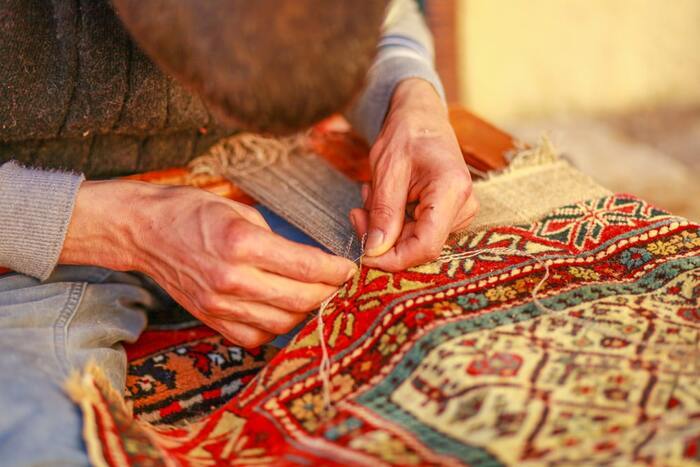Rugs are an essential addition to any home. With their wide range of designs, colours and textures, they’re incredibly versatile, appealing to everyone no matter what your style preferences are.
When buying a new rug, you’ll probably focus on what it looks like, considering things like colours, patterns and fabrics. But, considering how the rug has been made is also key. The construction of a rug can influence its durability, price, uses and cleaning requirements, so taking the time to understand how rugs are made is well worth the effort.
1. The origin of rugs
It’s thought that the very first rugs were made thousands of years ago by shepherds who wanted heavy garments to keep themselves warm. However, these were also used to cover floors to provide insulation. So the rug was born.
Over the years, rug making has enjoyed a rich and varied history, with traditions being passed down from generation to generation. Various methods to construct rugs by hand are heavily bound in the culture and heritage of different countries, and even many modern-day rugs which are made by machines still rely on techniques, customs and methods used in days gone by.
The intricate patterns, detailing and weaving techniques have turned making rugs into an art form, and many rugs are prized not only for their practical uses, but for their exquisite, aesthetic characteristics.
Here are some of the different ways that rugs are made.
2. Hand-knotted
The history of hand-knotted rugs is thought to span back to over 2,000 years, making it one of the most traditional forms of rug making. It’s an extremely slow process to hand-knot a rug, taking months, or even years in some cases. Because of the skill and time involved, hand-knotted rugs can be costly.
As the name suggests, rugs are knotted by hand, using a special type of loom. The fringe of the rug is constructed from vertical threads (warp) that are tied to the loom. The foundation of the rug is made from horizontal threads (weft) intertwined with the warp, with each knot hand tied to the vertical lines. They’re then carefully cut, and tied once more to secure the knots. This forms the ‘pile’ of the rug.
There are two techniques (Persian knot and Turkish knot) used to hand-knot rugs, depending on where the rug is being made. The main difference is that the Persian knot involves leaving a gap and is asymmetrical, whereas the Turkish knot technique is symmetrical.
An average rug can consist of around a thousand knots in every square inch. With a skilled weaver typically making about six knots each minute, it’s easy to appreciate that this is a really time-consuming method of rug making. However, the amount of time that’s invested in the construction of this type of rug makes it very robust, durable and of premium quality.
3. Hand-tufted
Instead of using a loom to make a hand-tufted rug, a special type of tool referred to as a tufting gun is used. Hand-tufting a rug doesn’t involve making knots. Instead, yarn is looped through the backing of the rug, with the tufting gun.
After the backing has had all of the yarn looped through it, additional foundation layers are applied. A scrim, which is a type of rubber or plastic grid, is added and secured with a strong glue. A protective backing is then fixed on top of this. The rug will then be sheared to cut the loops, creating the pile.
Most hand-tufted rugs are made from wool, but other materials like viscose or polyester may be used.
Hand-tufting a rug is the quickest method to create a rug by hand, and because it’s not as labour intensive as making a hand-knotted rug, it’s a more affordable option.
4. Hand-hooked
Using a similar process to tufting, the key difference with making hand-hooked rugs is that the loops stay intact and the yarn isn’t sheared, giving the rug a very unique appearance.
The beauty of the hand-hooked technique is that it can create intricate designs and colourful patterns due to the accuracy of the weaving process. However, this style of rug isn’t very durable, so wouldn’t suit being placed in a busy area that receives a lot of footfall.
5. Flat-woven
Rugs which are classed as flat-woven have no pile. Essentially, they lie flat. This makes them quite a thin rug, often usable on both sides.
To create a flat-woven rug, a special type of weaving method is used on a loom, whereby the yarn is completely entwined rather than protruding out to create a pile.
Flat-woven rugs can be made either by hand or by using a machine, and they can be constructed from different types of natural or synthetic materials. The colours produced in this type of rug can look vibrant and eye-catching, and as flat-woven rugs are affordable, they enjoy versatile use.
The lack of pile, however, does make any stains in a flat-woven rug more visible, and the thin construction of the rug makes them less durable compared to knotted or hand-tufted rugs.
6. Machine made
Because it can be quite labour intensive making rugs by hand, many rugs nowadays are mass-produced using machines, or power looms.
Automated and electronically controlled by computers, the power looms are capable of creating rugs using a range of synthetic materials, such as nylon, acrylic and polyester, and even natural materials like wool.
The machine creates the rug by intertwining the facing and backing yarns to form a woven product, without needing a secondary backing.
The benefit of machine made rugs is that large numbers can be quickly produced with little labour. For the consumer, these rugs boast many of the advantages of hand-made rugs, including durability, without the high cost. However, they may not have the same level of intricate details and patterns compared to rugs made by hand.
After a rug has been made, it’s often then carefully washed to eliminate any remaining yarn particles as well as any dirt or detergents.
How a rug is made can determine how it should be cleaned, so if your rugs are starting to look a bit dull, dirty or have a few stains, speak to our fully insured rug cleaning London professionals at Carpet Bright UK for expert cleaning assistance.







